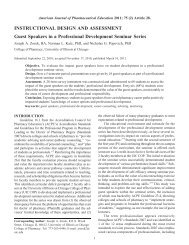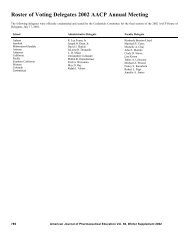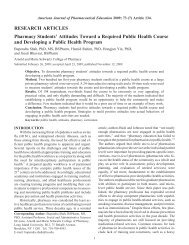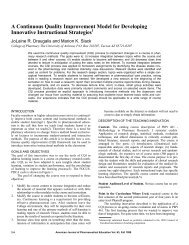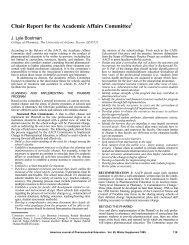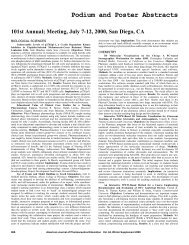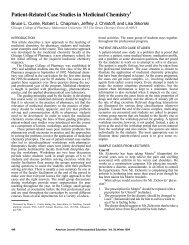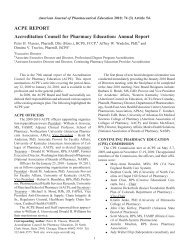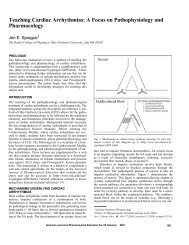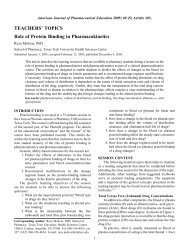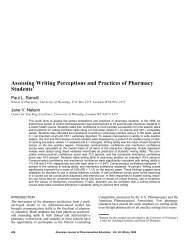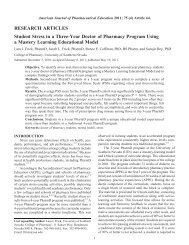Pharmacy Students' Perceptions of Pharmaceutical Care in ... - AJPE
Pharmacy Students' Perceptions of Pharmaceutical Care in ... - AJPE
Pharmacy Students' Perceptions of Pharmaceutical Care in ... - AJPE
You also want an ePaper? Increase the reach of your titles
YUMPU automatically turns print PDFs into web optimized ePapers that Google loves.
American Journal <strong>of</strong> <strong>Pharmaceutical</strong> Education 2004; 68 (1) Article 4.<br />
macy school educators are counter<strong>in</strong>g this perception <strong>of</strong><br />
pharmaceutical care as an ideal and not a reality by expos<strong>in</strong>g<br />
students to experienced practitioners who practice <strong>in</strong> a<br />
variety <strong>of</strong> sett<strong>in</strong>gs and by us<strong>in</strong>g actual patients <strong>in</strong> the classroom.<br />
4,7 It is important to consider whether students’ perceptions<br />
and observations validate teach<strong>in</strong>g <strong>of</strong> pharmaceutical<br />
care when students are <strong>in</strong>troduced to different practice<br />
environments early <strong>in</strong> the pharmacy school curriculum.<br />
Exposure <strong>of</strong> students to <strong>in</strong>novative practice models<br />
may foster development <strong>of</strong> those models. 5 This is a concept<br />
that is practiced <strong>in</strong> other health care pr<strong>of</strong>essions, such<br />
as medic<strong>in</strong>e and dentistry. 8-10 Learn<strong>in</strong>g patient care concepts<br />
by model<strong>in</strong>g preceptors prepares students to care for<br />
patients <strong>in</strong> a realistic practice environment. Students perform<br />
better and with <strong>in</strong>creased productivity compared with<br />
their performance <strong>in</strong> a laboratory sett<strong>in</strong>g. 10<br />
This research was designed to exam<strong>in</strong>e how pharmacy<br />
students perceive the importance <strong>of</strong> pharmaceutical<br />
care and to compare these perceptions between retail and<br />
cl<strong>in</strong>ic practice sett<strong>in</strong>gs. Also, students’ perceptions concern<strong>in</strong>g<br />
the importance <strong>of</strong> 20 aspects <strong>of</strong> pharmaceutical<br />
care were measured before and after a patient counsel<strong>in</strong>g<br />
course.<br />
2<br />
METHODS<br />
This study was designed to determ<strong>in</strong>e whether completion<br />
<strong>of</strong> a patient counsel<strong>in</strong>g course improved pharmacy<br />
students’ perceptions <strong>of</strong> the importance <strong>of</strong> pharmaceutical<br />
care and to determ<strong>in</strong>e whether there was a difference <strong>in</strong><br />
students’ perceptions <strong>of</strong> pharmaceutical care provided <strong>in</strong><br />
retail sett<strong>in</strong>gs compared to that provided <strong>in</strong> cl<strong>in</strong>ic sett<strong>in</strong>gs.<br />
The first objective was addressed us<strong>in</strong>g a s<strong>in</strong>glegroup,<br />
before-after study design. A pretest was adm<strong>in</strong>istered<br />
to 81 second-year Doctor <strong>of</strong> <strong>Pharmacy</strong> students who<br />
were enrolled <strong>in</strong> the Patient Counsel<strong>in</strong>g and Communication<br />
course (PHAR 385). An outl<strong>in</strong>e <strong>of</strong> the topics covered<br />
<strong>in</strong> this course is <strong>in</strong>cluded as Appendix 1. The objective <strong>of</strong><br />
this course was for students to understand the pr<strong>in</strong>ciples<br />
and techniques <strong>of</strong> communication applicable to pharmacy<br />
practice. All pharmacy students enrolled at The University<br />
<strong>of</strong> Louisiana at Monroe are required to complete this<br />
course <strong>in</strong> their second year <strong>of</strong> pr<strong>of</strong>essional school.<br />
A survey <strong>in</strong>strument was designed to measure students’<br />
perceptions <strong>of</strong> the importance <strong>of</strong> pharmacists’ perform<strong>in</strong>g<br />
20 items describ<strong>in</strong>g pharmaceutical care. A pretest<br />
was adm<strong>in</strong>istered dur<strong>in</strong>g the first week <strong>of</strong> classes dur<strong>in</strong>g<br />
the Fall 2001 semester. A Likert scale measur<strong>in</strong>g the<br />
level <strong>of</strong> importance was used, with “1” equal<strong>in</strong>g “unimportant”<br />
and “4” equal<strong>in</strong>g “very important.” A posttest<br />
us<strong>in</strong>g the same items was adm<strong>in</strong>istered to students dur<strong>in</strong>g<br />
the last week <strong>of</strong> classes <strong>in</strong> December 2001.<br />
For the second objective, each student was assigned to<br />
write a technical report follow<strong>in</strong>g a prescribed outl<strong>in</strong>e describ<strong>in</strong>g<br />
a counsel<strong>in</strong>g encounter observed between a pharmacist<br />
and a patient. A counsel<strong>in</strong>g encounter was def<strong>in</strong>ed<br />
as one-to-one <strong>in</strong>terpersonal communication between a<br />
pharmacist and a patient concern<strong>in</strong>g the patients’ medical<br />
condition and/or prescription for medication. Students<br />
were required to schedule an appo<strong>in</strong>tment with a pharmacist<br />
before observ<strong>in</strong>g the encounter. For the observation,<br />
each student selected either a retail or cl<strong>in</strong>ic pharmacy<br />
practice sett<strong>in</strong>g. Forty-seven students observed a pharmacist<br />
<strong>in</strong> a retail sett<strong>in</strong>g and 34 observed a pharmacist <strong>in</strong> a<br />
cl<strong>in</strong>ic sett<strong>in</strong>g. A retail sett<strong>in</strong>g was operationally def<strong>in</strong>ed as<br />
a cha<strong>in</strong> or <strong>in</strong>dependent pharmacy where prescriptions for<br />
pharmaceuticals were filled and dispensed. <strong>Pharmacy</strong> students<br />
who already served as <strong>in</strong>terns for a retail pharmacy<br />
were allowed to observe at the practice site where they<br />
worked. The alternate sett<strong>in</strong>g was an ambulatory care<br />
cl<strong>in</strong>ic. Students who self-selected a cl<strong>in</strong>ic pharmacy practice<br />
sett<strong>in</strong>g had a choice <strong>of</strong> observ<strong>in</strong>g a pharmacist <strong>in</strong> either<br />
the anticoagulation cl<strong>in</strong>ic or the diabetes-care cl<strong>in</strong>ic.<br />
The pharmacists who conducted both cl<strong>in</strong>ics were<br />
<strong>in</strong>dependently responsible for provid<strong>in</strong>g primary care.<br />
They ma<strong>in</strong>ta<strong>in</strong>ed care <strong>of</strong> patients between regularly scheduled<br />
physician appo<strong>in</strong>tments. This care <strong>in</strong>cluded obta<strong>in</strong><strong>in</strong>g<br />
patient history <strong>in</strong>formation, conduct<strong>in</strong>g a physical assessment,<br />
order<strong>in</strong>g or perform<strong>in</strong>g laboratory tests, manipulat<strong>in</strong>g<br />
drug therapy, and schedul<strong>in</strong>g follow-up visits. None <strong>of</strong><br />
the pharmacy students who chose to observe either <strong>of</strong> the<br />
ambulatory care cl<strong>in</strong>ics had ever been exposed to this type<br />
<strong>of</strong> practice sett<strong>in</strong>g.<br />
Students’ technical reports were graded based on<br />
completeness <strong>of</strong> the assignment. The reports were later<br />
analyzed us<strong>in</strong>g content analysis methodology. Students<br />
were not aware <strong>of</strong> the methodology used <strong>in</strong> this study. Although<br />
content analysis has been used <strong>in</strong> the social sciences<br />
to identify trends with<strong>in</strong> the discipl<strong>in</strong>e, it has also<br />
been used to assess literature that relates to controversial<br />
medical issues. 11-14 Specifically with<strong>in</strong> the field <strong>of</strong> medic<strong>in</strong>e,<br />
content analysis has been used to identify whether<br />
controversial scientific papers use language that is factual<br />
or emotional. 11 This methodology has also been used to<br />
analyze written messages to physicians from third year<br />
pharmacy students regard<strong>in</strong>g alternative drug therapy recommendations.<br />
15<br />
<strong>Pharmaceutical</strong> <strong>Care</strong> Variables<br />
Each pharmaceutical care variable was operationally<br />
def<strong>in</strong>ed as part <strong>of</strong> content analysis methodology. The follow<strong>in</strong>g<br />
variables were considered components <strong>of</strong> counsel<strong>in</strong>g<br />
sessions between pharmacists and patients that would<br />
most likely occur <strong>in</strong> both types <strong>of</strong> practice sett<strong>in</strong>gs. The<br />
variables were extracted from research literature on the<br />
core elements <strong>of</strong> pharmaceutical care, <strong>in</strong>clud<strong>in</strong>g the provision<br />
<strong>of</strong> drug <strong>in</strong>formation, education, and monitor<strong>in</strong>g <strong>of</strong><br />
drug therapy outcomes. 1-4,16<br />
Students were required to describe the follow<strong>in</strong>g as-



